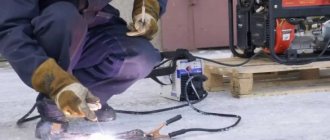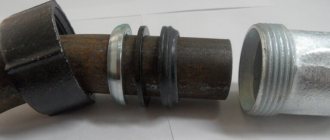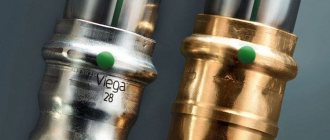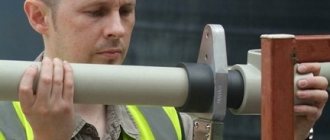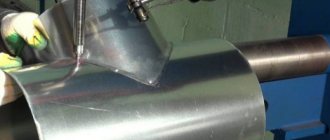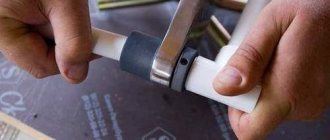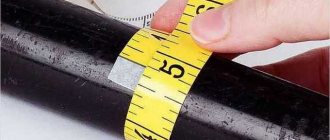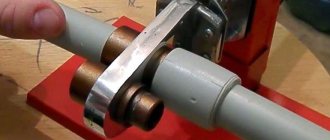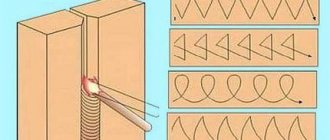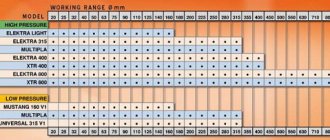To create durable and lightweight structures from profile pipes, three welding methods are used: electric arc, contact, gas. Each has its own characteristics, disadvantages, advantages.
Rolled products can be connected at any angle, in any plane, without compromising the integrity of the profile or damaging the inner surface. When welding a profile pipe, it is necessary to take into account the wall thickness.
Welding a profile pipe with your own hands
Of particular importance in the use of welding are profile pipes, which often have to be connected using it. In most cases, this type of pipe is made of either stainless or carbon steel. Such metal products have several advantages in their application:
- Large selection of types, shapes and sizes;
- The mass of both a single pipe and entire structures is not large. This allows you to connect them in complex configurations without creating a significant load on the load-bearing elements;
- You can select several standard types at once. This allows you to independently install the structure in the future.
The most important thing when independently fastening a profile pipe is the correct temperature. The fact is that the temperature conditions determine the quality with which the products will be welded. This indicator depends on the wall thickness of the workpiece. It should also be remembered that when making an end connection, the corners of the elements being welded have a high voltage.
Selection of material for work
When a person decides to reconstruct the fencing of his house, the manufacturing itself will not bring him any big problems and challenges. Initially, the necessary materials needed during the construction of a new fence are purchased, and in addition to them, additional tools will be needed and, of course, you need to prepare yourself completely for construction work. But, of course, you need to take into account that the manufactured gate must fit well with the rest of the fence. If the fence is made of rotten boards, then of course you should not make a door in the fence from the same rotten boards, but for example, if the fence is made of rods, then doors for it made of, for example, plastic would be completely inappropriate.
We recommend: DIY bed made from a profile pipe: instructions
Given the condition that currently building materials are very diverse, differ in their composition and price, but in the manufacture of a gate the basis is its frame. Which should be the most massive compared to the rest of the structure, since it will be directly mounted on poles dug into the ground and serving directly as a support.
After making the frame, its base is covered with metal mesh, steel sheets, wooden boards, pipes or other types of materials that were initially preferred. With greater imagination, manufacturing specialists approach the production of unique locks, but there are no more than three such designs:
- a lock placed directly on the frame itself, it can either be embedded into it or placed on top of the material from which the frame itself is made;
- a separate lock, which will later be threaded into soldered padlocks, that is, such a lock will also be a padlock;
- a latch that will be located on the inside of the door or an equally secret small bolt.
As for the most basic thing, that is, the supports on which the fence door will be fixed are almost identical in their base and structure, but may differ only in the material from which they are made. Such bases can be made of logs, strong profile pipes and other similar materials. If desired, such pillars can be faced with bricks.
When everything has already been selected and a plan has been developed, you can safely begin the main work. You should dig two holes in which the supports will later be located. It is best to dig a hole to a good depth, since if the pillars are poorly buried, then over time, even when they are filled with concrete, they will go downhill. That is, if you calculate approximately, then the support should be dug into the hole with at least one third of its part.
We recommend: Plugs for profile pipes: types
Before digging the pillars into the ground, they are treated with a primer so that the material is not susceptible to corrosion. If a pipe is selected as a support column, then plugs are first placed on it. When the pipe is pre-prepared for installation, you should place it in the hole and fix its desired position. The structure located in the ground is poured with a concrete solution, fix them and wait for the solution to dry completely. Take your time at this stage.
How to weld a profile pipe using manual arc welding?
The characteristics and simplicity of using the metal of a profile pipe allows you to connect it to each other in a variety of ways - a joint, a T-type method, and also an overlap. The lower position of the seams is a priority when welding metal profile elements.
The welding mode is determined by the following criteria:
- Electrode movement speed;
- Arc voltage;
- Polarity (assuming constant current);
- Current strength.
The last of these criteria is determined by the cross-sectional value of the electrode used. Welding of a profile pipe will be performed correctly and reliably only in one case - if it is possible to achieve the maximum current allowed for the metal. When welding using the butt welding method, the arc should be drawn so that the edges melt and the metal itself does not sag as a result.
Finished seam.
What to do to avoid burning through the walls?
Such defects occur when working with thin-walled workpieces. This problem can be avoided by choosing an electrode. For beginners, it is best to opt for consumables with a diameter of no more than 1.5 millimeters. The second very important nuance is the minimum permissible current values. It is also important to choose the reverse polarity of the connection.
You can burn through the wall of a corrugated pipe due to an incorrectly chosen welding method. To prevent this from happening, it is advisable to adhere to the following sequence of actions:
- the arc is ignited on the tack;
- the electrode is passed along the joint at a distance of 10-15 mm at an angle backwards
- oscillatory movements are excluded;
- the arc must be made as short as possible. Its distance from the melt should not exceed 1.5 mm. With a short arc, the voltage is lower, and, accordingly, the temperature of the melt;
- You cannot break the arc at the end of the joint. You need to go back 15-20 mm and remove the electrode from the joint at this point;
- Slag and melt splashes are removed.
Machines for welding profile pipes
You can connect metal pipes using two main types of devices:
- Arc welding;
- Gas welding.
Each of them has its own advantages and disadvantages. It is generally accepted that gas welding is more universal in its application. It can handle a wide variety of tasks and different types of metal. But not everyone can afford this type of welding machine.
The more common type is conventional arc welding. Therefore, all that is required for successful fastening of profile pipes:
- take into account the wall thickness of the product;
- select the optimal electrode diameter;
- set the correct voltage on the device.
What electrodes should be used to weld a profile pipe?
Since standard structural steel is used for the manufacture of profile pipes, you can use the standard, most common electrodes. For example, the OMA-2 brand is ideal for this purpose. The products of this brand include titanium concentrate and ferromanganese.
Video - Application of various electrodes:
Also, many experienced welders recommend using electrodes marked on the MT-2 packaging. They are usually used together with welding rectifiers. The main criterion for selection is a stable arc and uniform consumption of filler materials.
Types of electrodes
Welding a profile pipe: rules for forming a reliable connection
The basic rule for using arc welding is to correctly connect the elements and carefully fix them using the spot method. When all the products are in place and pressed tightly against each other, you just need to weld several points around the entire perimeter so that the structure does not fall apart.
After this, you can start scalding all the parts. The weld line is drawn smoothly. The filler material must be applied evenly. When using conventional electrodes, beginners can arc from side to side within a small range. Not all professionals use this approach, but for beginners the method is quite suitable.
The most important thing during this process is to form a neat roll from the material being processed. A straight weld line will be formed.
Welding of pipes with walls up to 2 mm thick
Working with thin metals is difficult and very labor-intensive. But if you choose the right consumables, many problems can be avoided. As practice shows, the optimal choice in this case will be electrodes with a diameter of 1.5-2 mm.
Electric welding is recommended to be used only by confident, experienced specialists. In electric arc welding, it is important to choose the right operating mode. And it will be extremely difficult to do this without experience. In any case, the current should not exceed the threshold of 60 amperes. In the selection of electrodes, it is advisable to give preference to the ANO-21 or MP-3S brands.
When joining thin-walled steel, different working methods can be used. Beginners prefer to grab the workpieces first, that is, do the work in a point-by-point manner. Therefore, an inverter will be the optimal equipment for them.
Many experts do not recommend resorting to gas welding in such operations. There is a high probability of deformation or burning through thin-walled material.
How to weld a profile pipe - your secrets
The first piece of advice would be to thoroughly clean the surfaces and, most importantly, to make a perfectly even cut of both sides that will be joined.
Experts with many years of experience always advise beginners to adhere to several basic points. Their effectiveness has been repeatedly applied in practice.
So, the main points of the connection, known only to the “experienced”:
- The main problem with inexperienced welders is that they forget to check the correctness of the entire structure. Always control the geometry of the metal. They often start to twist during welding. This is especially true for profile pipes.
- The quality of the seam and its reliability directly depend on the speed with which the elements are welded. The speed should be such that the specialist has time to fasten the products before the heated edge cools down.
- For profile pipes, propane-butane and acetylene torches are not used. Their temperature is too high.
We perform arc welding
Initially, you should bring the products into a specially prepared room. All ends of the pipes that will be connected are degreased. The chamfer remover is used only if the thickness of the profile pipe is more than 4 mm. After using this device, you can make a seam in several layers. It will be quite durable.
If the pipe thickness is less, one welding seam will be enough. All parts must be secured in a table specially designed for this purpose. If it is not there, then use the help of one or more people. Welding of the profile pipe will be carried out efficiently.
A certain thickness of the material, brand and cross-sectional thickness of the electrode sets the voltage with which the welding process must be performed.
The slag should be knocked down from time to time to avoid premature corrosion.
Electrode position options
Features of welding a frame made of corrugated pipe
Durable, lightweight, inexpensive - these are some of the advantages of frames made from profile pipes. They are in demand and used for a variety of purposes.
The peculiarity of creating such structures is the high probability of deformation of the workpieces and the varied spatial arrangement of seams. Most often, defects arise due to irregularities on the side faces of the pipes. In this case, the blanks do not fit together smoothly. You have to deposit more metal. And this in turn leads to overheating of parts.
And as a result - welding deformation. Leads a profile pipe. To prevent this from happening, special templates called jigs are used during welding. They fix the positions of the workpieces and they remain in this position until the process is completed. The use of conductors significantly increases the speed of assembly of structures. Their use in mass production is especially important.
Large items must be secured to the slipway. Clamps are best suited for this. First, the parts are tacked at the corners, and after that they are welded on the side opposite to the tack point. The formation of the seam starts from the middle and gradually moves towards the edge. In cases where workpieces of different thicknesses are connected, the arc should be ignited on the thicker one and then switch to the thinner one. Oscillatory movements can be circular or zigzag.
We perform gas welding
After preparing and degreasing the surfaces, apply flux paste. It will prevent oxide from forming. It is important to adhere to a certain bevel angle of the edges. It is usually 30˚.
How to weld a profile pipe correctly? The answer is simple - by feeding the additive evenly from start to finish in front of the flame. The burner will gently melt materials and connect pipes.
Gas welding has a distinctive feature. If the wall thickness exceeds 6 mm, the burner is moved from side to side. Thus, the level of acetylene consumption is reduced. And the parts are more firmly attached to each other.
Video - Horizontal gas seam:
